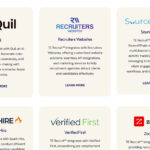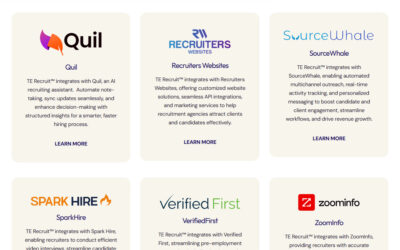The digital age has revolutionized human resources (HR), enabling professionals to streamline processes, enhance productivity, and drive meaningful impact on corporate culture and overall business success. Gone are the days when HR teams were buried under piles of paperwork and bogged down by manual data entry. Today, advanced technology solutions empower HR departments to operate more strategically, efficiently, and effectively, fostering a more agile and responsive workplace.
In this article from Top Echelon Recruiting Software, we explore three significant ways in which technology is transforming human resources and how organizations can leverage these tools to enhance human capital management and development.
1. Human Resources and the Cloud: Enhancing Efficiency and Accessibility
Cloud-based systems have revolutionized HR management, offering numerous benefits that enhance efficiency, flexibility, and scalability. These platforms provide a secure, centralized space for storing and accessing data, thereby reducing the administrative burden on HR teams and empowering employees to take control of their information.
Here are several key ways that cloud technology is reshaping HR functions:
Going Paperless: A Sustainable Approach to Data Management
One of the most significant advantages of cloud-based HR systems is the ability to go paperless. By digitizing documents and storing them securely in the cloud, organizations can reduce waste, save on storage costs, and minimize the risk of losing critical files during a disaster or data breach. Additionally, going paperless allows HR teams to access and retrieve information instantly, reducing time spent searching for physical files and enhancing overall productivity.
Creating Transparency and Accessibility: Anytime, Anywhere
Cloud technology promotes transparency by enabling authorized personnel to access data anytime, anywhere. Employees can easily update their personal information, view payslips, submit leave requests, and complete training modules without having to rely on HR intermediaries. This self-service model reduces the administrative workload on HR teams and fosters a culture of transparency and accountability.
Furthermore, cloud-based platforms offer advanced security features such as encryption and multi-factor authentication to protect sensitive employee data. This level of security helps organizations maintain compliance with data protection regulations, such as the General Data Protection Regulation (GDPR) and the California Consumer Privacy Act (CCPA).
Improving Productivity through Automation and Integration
Cloud-based HR solutions often come with built-in automation features that streamline routine tasks like payroll processing, benefits administration, and performance reviews. These tools can integrate with other enterprise software systems, such as Customer Relationship Management (CRM) or Enterprise Resource Planning (ERP) platforms, to create a seamless flow of information across departments.
For example, an integrated HR and payroll system can automatically update employee records when a promotion or salary change occurs, reducing the likelihood of errors and saving time. Similarly, automated workflows can help manage onboarding, performance evaluations, and offboarding processes, ensuring a consistent and compliant approach.
2. Enhancing Collaboration and Communication: Bridging the Gap in a Hybrid World
In today’s dynamic work environment, organizations often have a mix of remote employees, office-based staff, freelance workers, and distributed teams across various locations. Ensuring effective communication and collaboration among these diverse groups is crucial to maintaining productivity and fostering a cohesive workplace culture.
HR departments, in partnership with IT teams, play a vital role in selecting and implementing collaboration and communication tools that align with the organization’s goals. These tools must facilitate seamless information sharing, foster engagement, and build a sense of community among employees.
Centralizing Critical Files and Information
A robust collaboration platform should serve as a central hub for all critical files and information, offering secure access to documents, project plans, and communication threads. Tools like Microsoft Teams, Slack, and Google Workspace provide features that allow teams to share documents, co-edit in real time, and track version history, reducing the chances of errors and ensuring everyone has access to the latest information.
Fostering Team Building through Interactive Features
Modern collaboration tools go beyond basic messaging and email functions; they incorporate features like video conferencing, virtual whiteboards, emoji reactions, and even games to create an interactive and engaging experience. For example, Zoom and Microsoft Teams offer virtual breakout rooms that enable small group discussions, which can be especially useful for remote brainstorming sessions, training programs, or team-building activities.
These tools help build a sense of camaraderie among team members, regardless of their location, and encourage a more inclusive workplace environment. HR can also use these platforms to conduct virtual town halls, webinars, and company-wide updates to keep employees informed and engaged.
Ensuring User-Friendly and Secure Solutions
When selecting collaboration tools, it’s essential to consider ease of use and the level of training required for effective implementation. User-friendly interfaces and intuitive features ensure employees can quickly adapt to new tools, reducing the learning curve and increasing overall adoption rates. At the same time, robust security measures, such as encryption, access controls, and data loss prevention, are critical to protecting sensitive company information and maintaining regulatory compliance.
3. Blockchain Technology in HR: Revolutionizing Data Integrity and Security
While blockchain technology is most commonly associated with cryptocurrencies like Bitcoin, its potential applications in HR extend far beyond digital currency. Blockchain offers a decentralized and secure way to store and verify data, making it a powerful tool for HR professionals looking to automate and streamline data management processes.
Here are some promising use cases for blockchain technology in HR:
Verifying Credentials and Background Information
Blockchain can significantly enhance the recruitment process by providing a tamper-proof method for verifying a candidate’s credentials, such as degrees, certifications, and work experience. With blockchain, candidates can authorize educational institutions and certifying bodies to upload their verified credentials to a secure digital ledger. This eliminates the need for time-consuming manual verification processes and reduces the risk of fraudulent claims.
For example, companies like IBM and Walmart are already exploring blockchain technology to authenticate employee credentials and streamline hiring processes. As more organizations adopt this technology, it will become easier to quickly verify a candidate’s background, allowing HR professionals to focus on finding the best fit for their organization.
Streamlining International Payroll and Cross-Border Payments
Managing payroll for a global workforce can be complex and costly, particularly when dealing with different currencies, regulations, and banking systems. Blockchain technology offers a solution by enabling secure, transparent, and efficient cross-border payments. With blockchain, payments can be made directly from the employer to the employee, bypassing intermediary banks and reducing transaction fees and delays.
For instance, companies like Bitwage have already started using blockchain to facilitate international payroll, ensuring faster payments and lower costs. As global workforces become more prevalent, blockchain could become a standard solution for managing international payroll.
Ensuring Data Privacy and Compliance
Blockchain’s decentralized nature ensures that data is stored across multiple nodes, making it highly secure and resistant to tampering or hacking. This capability makes blockchain an ideal tool for managing sensitive HR data, such as employee records, performance evaluations, and disciplinary actions. By maintaining a transparent and immutable ledger of data, organizations can better comply with data protection regulations and enhance overall data security.
As more businesses begin to leverage blockchain for HR purposes, we can expect new opportunities for better human capital management, data integrity, and compliance to emerge.
Embracing New HR Technology Trends: A Path to Competitive Advantage
From recruitment to retention, HR professionals now have more tools than ever to make their processes more efficient, effective, and impactful. As technology continues to evolve, it’s crucial for HR teams to stay informed about the latest trends and innovations that can drive their strategies forward. Here are some emerging HR technology trends to watch:
Artificial Intelligence (AI) and Machine Learning (ML) in Talent Acquisition
AI and ML are revolutionizing the way HR professionals source, screen, and select candidates. These technologies can analyze large volumes of data to identify patterns and predict which candidates are most likely to succeed in a given role. AI-powered tools can automate repetitive tasks, such as resume screening, reducing time-to-hire and minimizing unconscious bias.
Moreover, AI chatbots can engage with candidates throughout the recruitment process, answering questions, providing updates, and scheduling interviews, all while delivering a personalized experience that enhances employer branding.
Virtual Reality (VR) and Augmented Reality (AR) for Training and Development
VR and AR are transforming employee training and development by providing immersive and interactive learning experiences. For instance, VR can simulate real-world scenarios, allowing employees to practice their skills in a safe and controlled environment. AR can overlay digital information onto physical objects, enhancing learning experiences for technical roles or hands-on tasks.
Organizations like Walmart and Boeing have already adopted VR and AR for training purposes, resulting in improved retention rates, reduced training costs, and increased employee engagement.
Predictive Analytics for Workforce Planning
Predictive analytics is becoming an essential tool for HR departments to forecast workforce needs, identify skill gaps, and plan for future talent requirements. By analyzing historical data, predictive analytics can help HR professionals make data-driven decisions about hiring, promotions, and employee development.
For example, predictive models can identify employees at risk of leaving, enabling HR teams to take proactive measures to retain top talent. These insights can also inform succession planning and workforce restructuring, ensuring that organizations have the right people in the right roles at the right time.
Stay Ahead with the Latest HR Technology
To remain competitive and attract top talent, organizations must prioritize technology adoption and skills development in their HR departments. By embracing the latest technology trends, HR teams can drive greater impact on business outcomes, enhance employee experiences, and create a more agile and responsive workplace.
Are you ready to take your HR strategy to the next level with cutting-edge technology? Top Echelon Software offers comprehensive solutions designed to streamline your HR processes, enhance candidate engagement, and optimize human capital management.
Contact us today to schedule a demo and see how Top Echelon Software can transform your HR operations and help your organization attract, retain, and develop the best talent in the industry.








